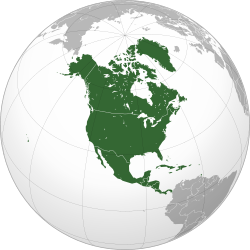Continental fragment
Continental crustal fragments, partially synonymous with microcontinents,[1] are fragments of continents that have broken off from main continental masses to form distinct islands, often several hundred kilometers from their place of origin.[2] All continents are fragments; the terms "continental fragment" and "microcontinent" are usually restricted to those smaller than Australia, taking Australia conventionally as the smallest continent. Continental fragments include some seamounts and underwater plateaus.
Some microcontinents are fragments of Gondwana or other ancient cratonic continents: these include Madagascar; the northern Mascarene Plateau, which includes the Seychelles; the island of Timor,[3] etc. Other islands, such as several in the Caribbean Sea, are composed largely of granitic rock as well, but all continents contain both granitic and basaltic crust, and there is no clear dividing line between islands and microcontinents under such a definition. The Kerguelen Plateau is a large igneous province formed by a volcanic hot spot; however, it was associated with the breakup of Gondwana and was for a time above water, so it is considered a microcontinent, though not a continental fragment.[4][5] Other hotspot islands such as Iceland and Hawaii are considered neither microcontinents nor continental fragments. Not all islands can be considered microcontinents: the British Isles, Sri Lanka, Borneo, and Newfoundland, for example, are each within the continental shelf of an adjacent continent, separated from the mainland by inland seas flooding its margins.
Several islands in the eastern Indonesian archipelago are considered continental fragments, although this designation is controversial. These include Sumba, Timor (Nusa Tenggara), Banggai-Sulu Islands (Sulawesi), Obi, southern Bacan, and the Buru-Seram-Ambon complex (Maluku).[6]
- Continental fragments (pieces of Pangaea smaller than Australia)
- Azores Plateau
- Bollons Seamount – A continental fragment seamount southeast of New Zealand
- East Tasman Plateau – A submerged microcontinent south east of Tasmania
- Gilbert Seamount – A continental fragment seamount west of New Zealand
- Jan Mayen Microcontinent – A fragment of continental crust within the oceanic part of the western Eurasian Plate northeast of Iceland
- Madagascar – Island country in the Indian Ocean
- Mascarene Plateau – Submarine plateau in the Indian Ocean, north and east of Madagascar
- Mauritia – A Precambrian microcontinent that broke away as India and Madagascar separated
- Parts of Wallaby Plateau
- Possibly Sumba, Timor, and other islands of eastern Indonesia; Sulawesi formed via the subduction of a microcontinent
- Rockall Plateau
- Socotra – largest of four islands of the Socotra Archipelago, Yemen[7]
- South Orkney Microcontinent[8]
- Zealandia – Mostly submerged mass of continental crust containing New Zealand and New Caledonia
- Other microcontinents (formed post-Pangaea)
- Barbados – Island country in the Caribbean
- Cuba, Hispaniola, Jamaica, and other granitic Caribbean islands
- Kerguelen Plateau – Submerged micro-continent in the southern Indian Ocean
References
- "Microcontinent" was initially the broader term, because it was defined morphologically rather than genetically (in term or genesis or origin). Scrutton, Roger A. (1976) "Microcontinents and Their Significance" pp. 177–189 In Drake, Charles L. (1976) (editor) Geodynamics: Progress and Prospects American Geophysical Union, Washington, D.C., ISBN 978-0-87590-203-6. But, using Scrutton's definition, "microcontinent" is a narrower term, excluding aseismic ridges of continental material, such as the Lomonosov Ridge and the Jan Mayen Ridge, which could still be considered "continental fragments".
- Monk, K.A.; Fretes, Y.; Reksodiharjo-Lilley, G. (1996). The Ecology of Nusa Tenggara and Maluku. Hong Kong: Periplus Editions Ltd. pp. 41–43. ISBN 978-962-593-076-3.
- Monk, K.A.; Fretes, Y.; Reksodiharjo-Lilley, G. (1996). The Ecology of Nusa Tenggara and Maluku. Hong Kong: Periplus Editions Ltd. pp. 27–29. ISBN 978-962-593-076-3.
- UT Austin scientist plays major rule in study of underwater "micro-continent". Retrieved on 2007-07-03
- Sci/Tech 'Lost continent' discovered Retrieved on 2007-07-03
- Monk, K.A.; Fretes, Y.; Reksodiharjo-Lilley, G. (1996). The Ecology of Nusa Tenggara and Maluku. Hong Kong: Periplus Editions Ltd. p. 41. ISBN 978-962-593-076-3.
- "Socotra Archipelago – a lifeboat in the sea of changes: advancement in Socotran insect biodiversity survey" (PDF). Acta Entomologica Musei Nationalis Pragae. 52 (supplementum 2): 1–26. Archived from the original (PDF) on 2013-11-11.
- R. A. J. Trouw; C. W. Passchier; L. S. A. Simőes; R. R. Andreis; C. M. Valeriano (1997). "Mesozoic tectonic evolution of the South Orkney Microcontinent, Scotia arc, Antarctica". Geological Magazine. 134 (3): 383–401. Bibcode:1997GeoM..134..383T. doi:10.1017/S0016756897007036. hdl:11449/36781.
.svg.png)
.svg.png)
.svg.png)
.svg.png)


.svg.png)
_political.svg.png)
.svg.png)
.svg.png)
.svg.png)